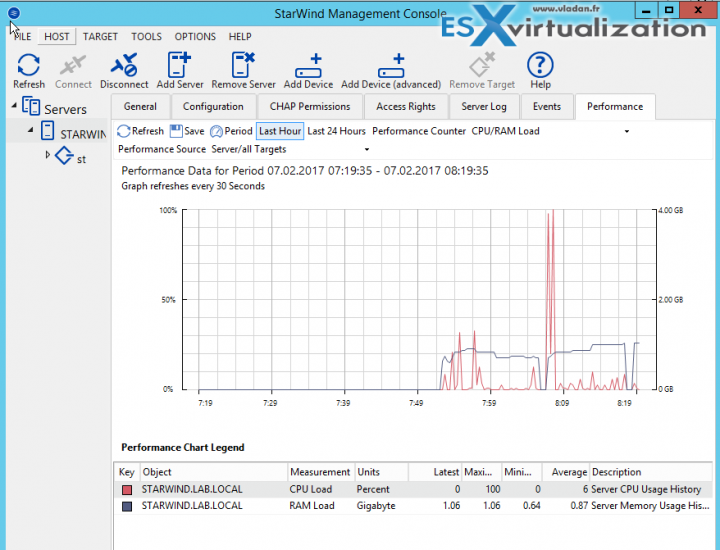NVMe Over Fabric (NVMe-Of) is a protocol which is defacto becoming high-speed standard to take advantage of huge IOPS provided by new NVMe devices hitting the market. NVMe-OF Target designed by StarWind is one of the latest and hot storage technologies overtaking old iSCSI.
First of all, before we go further, let's recap what is NVMe Over Fabric (Of) Target and then give you some further details about the configuration. NVMe-OF can be connected on the host on demand and provide really fast NVMe storage.
NVMe-over-Fabric is a newer standard that maps NVMe to RDMA in order to allow remote access to storage devices over an RDMA fabric using the same NVMe language.
StarWind support for NVMe over Fabrics (NVMe-oF) – the protocol tailored to squeeze maximum NVMe performance at minimum latency and CPU utilization. NVMe has larger queue depth than SCSI (64000 over 254 for SAS, or 31 for SATA).
Quote from StarWind
StarWind NVM-oF Target delivers your applications the maximum IOPS that high-performing NVMe storage could ever provide. This protocol has been purpose-designed for fast communication with the NVMe storage over high-speed networks with a reasonable portion of server CPU power involved. So, both NVMe devices and CPUs are utilized efficiently bringing you high ROI.
Latency-dependent applications get a consistent microsecond-scale latency with StarWind NVMe-oF Target. The protocol features multiple parallel command queues, 64 thousand commands each. Moreover, once combined with high-speed RDMA, NVMe-oF Target enables your applications to achieve almost the instant request response. Speaking of numbers, this protocol enables to build almost 8 times more efficient NVMe storage than if you use any SCSI-derived protocol.
As you can see, NVMe-OF has lower latency than iSCSI and it's faster and more efficient.
Here is an architectural overview.
In fact, Starwind has a detailed post about the whole configuration, but basically what's necessary is:
- StarWind on Windows
- CentOS machine
- Pair of Mellanox ConnectX-5 100Gbs network adapters
The NVMe-oF Target is created on Windows Server 2016 using StarWind NVMe over Fabrics Target service and discovered and connected on CentOS 7.5 via 172.16.77.x subnet.
What's the steps?
- Basically, at one end you have Windows server where you install StarWind VSAN. After, you'll make sure to install the latest Mellanox drivers (provided via StarWind's post).
- On the other side, you'll have Cent OS with kernel version higher than 4.9, with some additional packages.
- Configure a storage pool
- Enable iSER on Network adapter
- You'll create an NVMe-Of Target via StarWind Management console
- Discover and connect the NVMe-Of Target on CentOS system
- Done
You can find the detailed blog post about the whole configuration here – StarWind Virtual SAN Creating NVMe-oF Target. From the same page, you can also download a PDF version of the configuration steps.
Screenshot from StarWind.
The advantages of NVMe-Of are:
- Lower latency
- Greater throughput and speed
StarWind is very flexible when it comes to installation and configuration. It can adapt to different scenarios and fill in different architectural choices. By providing the latest storage technologies, such as NVMe-Of target, it's clear that innovation never stops.
About StarWind
- StarWind Virtual SAN for Hyper-V – is a Software-Defined-Storage stack designed specifically for implementation on the Microsoft’s virtualization platform. VSAN installs as a bare metal Windows application directly on the Hyper-V cluster nodes intended for the virtualization. Once installed, it creates a highly available storage pool for the entire cluster. StarWind VSAN for Hyper-V smoothly integrates with Windows Server management and security tools to provide administrators with a centralized user-friendly StarWind Management Console.
- StarWind Virtual SAN for vSphere -is a VMware-only Software-Defined-Storage stack. A ready-to-go Linux VM installs on the cluster nodes to share their storage resources.
Once installed, Virtual SAN creates a fault-tolerant storage pool available to the entire vSphere cluster. VSAN users get limitless virtualization capabilities in terms of features, storage capacity, and cost-efficiency. Enterprise-level functionality and performance are available in the infrastructure of your choice.
StarWind Virtual SAN FREE Version Features:
StarWind Virtual SAN Free is completely unrestricted: it is allowed for production use, supports all usage scenarios of the commercial version, has a perpetual license, and is not feature- or functionality-limited version of StarWind VSAN.
- No Capacity Restrictions – you can use as many capacities for your mirrors, as you like (previously restricted)
- No Scalability Restrictions – as many nodes as you like. (previously limited to 2-nodes only)
- No Time Limit on License – The Free license if for life. After 30 days, the only management option you’ll have is PowerShell or CLI.
- Production use – can be used in production, but if anything goes wrong, you will only find support through community forums.
- PowerShell Scripts – StarWind Virtual SAN Free is shipped with a set of ready to use PowerShell scripts allowing users to quickly deploy the Virtual SAN infrastructure.
- No StarWind Support – only community-based support.
- StarWind HA – The shared Logical Unit is basically “mirrored” between the hosts, maintaining data integrity and continuous operation even if one or more nodes fail. Every active host acts as a storage controller and every Logical Unit has duplicated or triplicated data back-end.
- No virtual tape library VTL as on the paid version.
More posts about StarWind on ESX Virtualization:
- StarWind Supports SMB3 – Did you Know?
- Veeam 3-2-1 Backup Rule Now With Starwind VTL
- StarWind and Highly Available NFS
- StarWind Storage Appliance Protects up to 4 disk failures
- How-To Install Hyper-V Cluster 2-Node Windows Server 2016 With StarWind Virtual SAN
- VMware VSAN Ready Nodes in StarWind HyperConverged Appliance
More from ESX Virtualization
- How VMware HA Works?
- What is VMware Cluster?
- Windows Server 2019 What’s new?
- Free Tools
- Install and Configure VMware vCSA 6.7
Stay tuned through RSS, and social media channels (Twitter, FB, YouTube)



